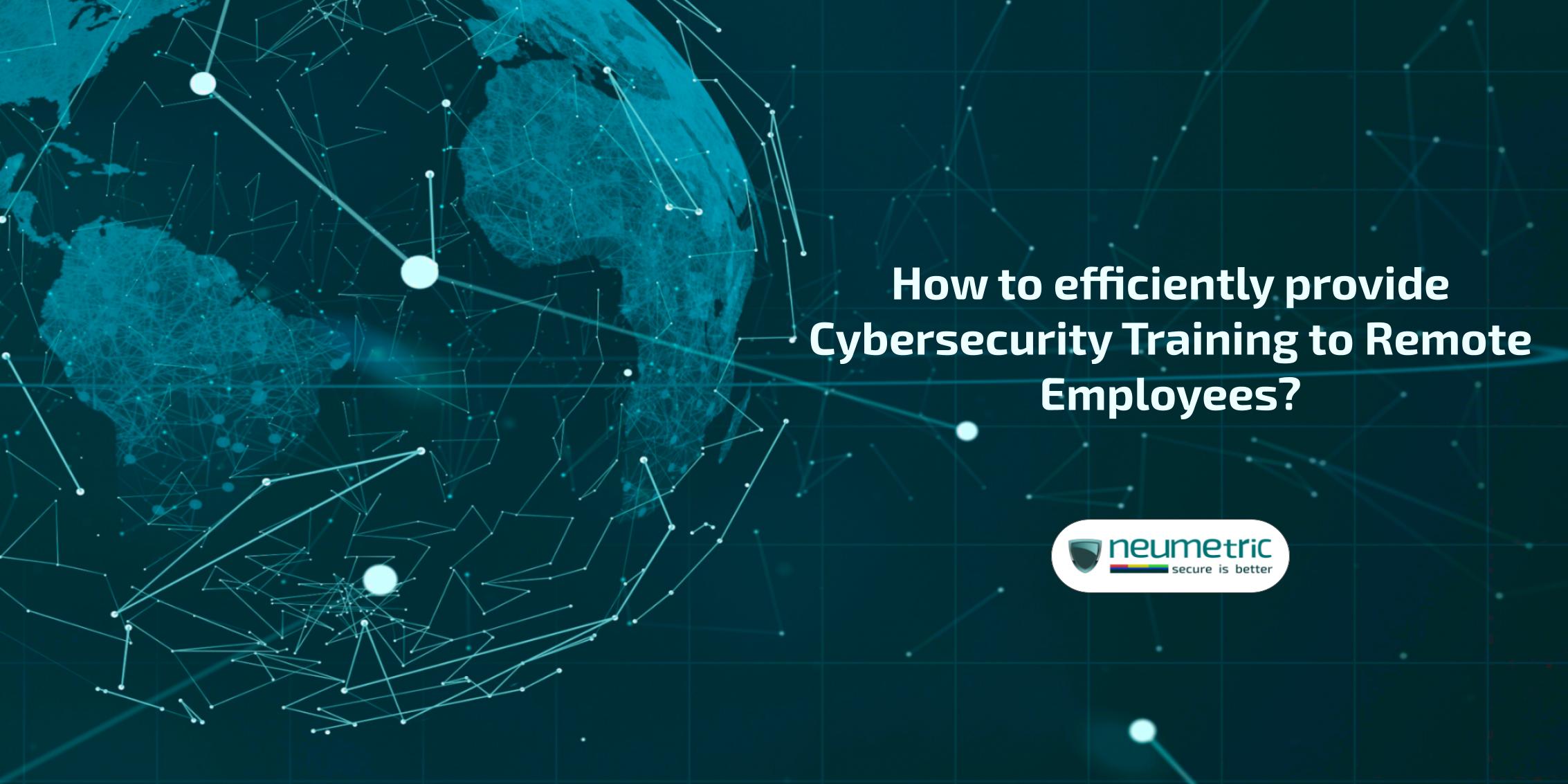Table of Contents
ToggleHow to efficiently provide Cybersecurity Training for Remote Employees?
Introduction
The professional landscape is undergoing a profound transformation with the widespread adoption of remote work. This shift has not only redefined how we work but also brought forth new challenges in the realm of cybersecurity. Remote work has evolved from a convenient option to a necessity, driven by technological advancements & global circumstances.
The traditional office setup is no longer the sole domain of professional interactions, as remote work becomes increasingly prevalent. This paradigm shift, while offering flexibility & accessibility, has opened a box of cybersecurity challenges. The once well-defined security perimeters of office networks are now diffused, exposing organizations to a myriad of potential threats.
As the workforce disperses, remote employees become the first line of defense against cyber threats. The significance of providing comprehensive & efficient cybersecurity training to these remote warriors cannot be overstated. Their awareness, knowledge & adherence to best practices are pivotal in safeguarding sensitive data & maintaining the integrity of organizational systems.
Cybersecurity Landscape in Remote Work
Common threats: Phishing, ransomware, endpoint security
- Phishing Attacks: With the dispersed nature of remote work, phishing attacks have become more sophisticated & prevalent. Employees operating outside secure office networks are often targeted through deceptive emails & malicious links.
- Ransomware Threats: The decentralized nature of remote work introduces new vulnerabilities to ransomware attacks. Cybercriminals exploit potential weak points, holding sensitive data hostage & demanding ransoms for release.
- Endpoint Security Challenges: As employees connect from various devices & locations, ensuring robust endpoint security becomes a paramount concern. Every device serves as a possible vulnerability for cyber threats.
Impact of remote work on traditional cybersecurity measures
- Expanded Attack Surface: The dissolution of traditional office boundaries significantly expands the attack surface for cyber threats. Remote work introduces a multitude of entry points that demand a reevaluation of conventional security strategies.
- Network Security Complexity: Traditional network security models designed for centralized office spaces may struggle to adapt to the distributed nature of remote work. Securing data transmission & maintaining network integrity become more intricate tasks.
- Authentication & Access Challenges: Verifying user identities & managing access controls become more challenging in remote work scenarios. Ensuring that only authorized individuals can access sensitive information becomes a critical concern.
Employee awareness as a key factor in preventing cyber threats
- Human Firewall: Remote employees act as the first line of defense against cyber threats. Their awareness of common threats, such as phishing attempts, plays a pivotal role in thwarting potential attacks.
- Training for Vigilance: Educating employees about cybersecurity best practices cultivates a culture of vigilance. Recognizing & reporting suspicious activities contribute to a collective effort in preventing cyber threats.
- Promoting Device Hygiene: Remote employees need to be vigilant about the security of their devices. Simple measures like regular updates, strong passwords & secure Wi-Fi connections can significantly reduce vulnerabilities.
In the dynamic landscape of remote work, understanding & addressing these cybersecurity challenges are foundational steps toward building a resilient defense against evolving threats.
Challenges of Remote Cybersecurity Training
Effectively delivering cybersecurity training in a remote work environment comes with its unique set of challenges. In this section, we explore & provide insights into overcoming these hurdles to ensure a comprehensive & impactful training program.
Lack of face-to-face interaction
The absence of in-person communication poses challenges in conveying complex cybersecurity concepts & gauging participant understanding. To address this:
- Virtual Engagement Platforms: Utilize interactive video conferencing tools & collaboration platforms to simulate face-to-face interactions. Conducting live Q&A sessions & discussions fosters engagement & clarifies doubts.
- Peer-to-Peer Interaction: Encourage remote employees to engage with each other through virtual forums or discussion boards. This collaborative approach facilitates knowledge-sharing & creates a sense of community.
Adapting to diverse technology environments
Remote work environments vary significantly in terms of technology infrastructure. To ensure training is accessible & effective for all:
- Platform Agnosticism: Design training content that is compatible with a variety of devices & operating systems. This ensures that employees using different technologies can seamlessly access & participate in the training.
- Training Modularity: Break down the training into modular components, allowing employees to progress at their own pace. This accommodates diverse learning speeds & avoids overwhelming participants with extensive sessions.
Balancing productivity & training time
Remote employees often juggle multiple responsibilities, making it challenging to allocate dedicated time for training. To strike a balance:
- Flexible Training Schedules: Provide flexibility in training schedules, allowing employees to choose convenient time slots. This ensures that training does not disrupt productivity but complements their work routine.
- Microlearning Approach: Adopt a microlearning strategy, delivering content in short, focused bursts. This not only facilitates better retention but also allows employees to absorb information during brief breaks in their workday.
Overcoming resistance to virtual training methods
Resistance to virtual training methods can impede the effectiveness of cybersecurity training programs. To address this resistance:
- Interactive Content: Develop engaging & interactive training materials, such as gamified scenarios & simulations. These methods enhance participation & make the learning experience more enjoyable.
- Clear Communication: Transparently communicate the benefits of virtual training, emphasizing its flexibility & convenience. Addressing concerns & showcasing the relevance of the training to daily work activities can alleviate resistance.
Developing an Effective Remote Training Program
Tailoring content to remote scenarios
To resonate with remote employees, cybersecurity training content must be specifically designed for their work context:
- Real-world Relevance: Embed case studies & examples that directly relate to remote settings. This enhances the practical applicability of the training, making it more relatable for participants.
- Remote-Specific Scenarios: Introduce scenarios that mirror the challenges employees may encounter while working remotely. This ensures that the training addresses the unique cybersecurity risks associated with decentralized work environments.
Using interactive methods: Simulations, gamification
Engagement is key in remote training. Incorporate interactive elements to elevate the learning experience:
- Virtual Simulations: Simulate real-world cyber threats & responses, allowing employees to practice in a controlled environment. This hands-on approach enhances understanding & prepares them for potential scenarios.
- Gamification Techniques: Implement gaming elements such as quizzes, challenges & rewards to make the training more interactive & enjoyable. This not only boosts engagement but also motivates employees to actively participate.
Customizing schedules to fit remote dynamics
Recognizing the time constraints & varied schedules of remote workers is crucial:
- Flexible Training Modules: Structure the training program in modular formats, enabling employees to complete sections at their own pace. This flexibility accommodates diverse schedules & ensures that training aligns with their workflow.
- On-Demand Learning: Provide access to training materials that employees can review at their convenience. This on-demand approach allows them to engage with the content when it best suits their work & personal commitments.
Incorporating continuous learning with regular updates
Cyber threats evolve & so should the training. Establish a framework for continuous learning:
- Regular Training Updates: Keep the content current by consistently updating it to reflect the latest cybersecurity threats & best practices. This ensures that employees are equipped with the most relevant information.
- Periodic Assessments: Implement regular assessments to gauge employees’ understanding & identify areas that may require additional focus. Adjust training content based on these assessments to enhance its effectiveness.
Leveraging Technology for Remote Training
Choosing suitable cybersecurity training platforms
- Scalability & Flexibility: Select platforms that can scale with the organization’s needs & offer flexibility to adapt to changing requirements. This ensures long-term viability & accommodates growth.
- Interactive Features: Choose platforms that support interactive features such as quizzes, discussions & progress tracking. These features enhance engagement & provide valuable insights into employee performance.
Utilizing video conferencing & e-learning tools
- Video Conferencing Tools: Leverage video conferencing platforms for live training sessions, fostering a sense of connection among remote participants. Interactive discussions & Q&A sessions can be conducted in real-time.
- E-Learning Platforms: Utilize e-learning platforms for asynchronous learning. This allows employees to access training materials at their own pace, promoting flexibility & accommodating diverse learning styles.
Integrating practical exercises for hands-on experience
- Hands-On Labs: Integrate practical exercises & hands-on labs that simulate real-world scenarios. This provides employees with tangible experience in responding to cybersecurity threats in a controlled environment.
- Cybersecurity Challenges: Implement challenges & scenarios that encourage employees to apply their knowledge. This not only reinforces learning but also enhances problem-solving skills in a cybersecurity context.
Fostering a Culture of Cybersecurity Awareness
Communicating the importance of cybersecurity to remote employees
- Clear Communication: Convey the critical role of cybersecurity in remote work settings through clear & concise communication. Illustrate the potential impact of cyber threats on both individual & organizational levels.
- Real-World Examples: Share real-world examples of cybersecurity incidents, emphasizing how they can directly affect remote employees. Concrete scenarios enhance understanding & highlight the relevance of cybersecurity vigilance.
Encouraging proactive threat identification & reporting
- Anonymous Reporting Channels: Establish confidential reporting channels for employees to comfortably disclose potential threats. Assurance of anonymity encourages proactive identification & reporting of suspicious activities.
- Training on Identification Techniques: Provide training modules focused on recognizing common cybersecurity threats. Equip employees with the knowledge & skills to identify potential risks, fostering a proactive approach to threat mitigation.
Recognizing & rewarding cybersecurity-conscious behavior
- Recognition Programs: Implement recognition initiatives for employees who consistently exhibit cybersecurity-conscious behavior. Publicly acknowledge their contributions to creating a secure remote work environment.
- Incentive Systems: Introduce incentive systems tied to cybersecurity awareness & adherence. Rewards, whether tangible or intangible, motivate employees to actively engage in maintaining a cyber-resilient workplace.
Monitoring & Assessing Training Effectiveness
Implementing regular assessments & quizzes
- Frequency: Conduct regular assessments & quizzes throughout the training program. This ensures ongoing engagement & helps reinforce key concepts.
- Diverse Formats: Use a variety of assessment formats, including multiple-choice questions, scenario-based quizzes & practical exercises. Diversifying assessments cater to different learning preferences.
Analyzing performance to identify improvement areas
- Data Analytics Tools: Leverage data analytics tools to track individual & collective performance. Identify specific areas where employees may require additional support or targeted training.
- Benchmarking: Establish benchmarks for performance metrics, enabling comparisons over time. Benchmarking facilitates the identification of trends & areas for improvement in the overall cybersecurity posture.
Gathering feedback for continuous enhancement
- Surveys & Feedback Sessions: Regularly collect feedback from participants regarding the training program. Surveys & feedback sessions provide valuable insights into the effectiveness of content delivery & areas for improvement.
- Iterative Improvement: Use gathered feedback to iteratively enhance the training program. Address identified shortcomings promptly, ensuring that the training remains aligned with the evolving needs of remote employees.
Overcoming Obstacles in Remote Training
Addressing connectivity & technological challenges
- Technology Support: Provide robust technical support to address connectivity issues promptly. Ensuring that remote employees have access to necessary resources enhances their engagement with the training program.
- Alternative Access Options: Offer alternative access options, such as offline materials or downloadable resources, for employees facing persistent connectivity challenges. This ensures continuous learning despite technological limitations.
Motivating & engaging remote employees
- Interactive Elements: Integrate engaging elements like quizzes, discussions & real-world scenarios. Gamification can also be employed to make the training more enjoyable & motivate active participation.
- Recognition & Rewards: Acknowledge the effort & commitment of remote employees in their cybersecurity training journey. Recognizing & rewarding achievements boost motivation & reinforce the value of the training.
Handling resistance to change & new methodologies
- Change Management Strategies: Implement effective change management strategies to address resistance. Clearly communicate the benefits of the new training methodologies & emphasize their relevance to remote work scenarios.
- Training Advocates: Identify & involve training advocates within the organization. Peer influence can be a powerful motivator in encouraging reluctant individuals to embrace new training methodologies.
Conclusion
In conclusion, as the landscape of work continues to evolve, the imperative of ensuring robust cybersecurity in remote environments becomes increasingly apparent. This comprehensive journal has outlined the critical components of navigating this new paradigm successfully. From understanding the prevalent threats in a remote setting to crafting tailored training programs & overcoming inherent challenges, organizations can fortify their defenses against cyber threats.
By fostering a culture of cybersecurity awareness, organizations empower their remote workforce to be not just employees but vigilant guardians of digital assets. Communication, proactive threat identification & recognition of cybersecurity-conscious behavior contribute to creating a resilient & security-minded community within the remote workforce.
Continuous monitoring & assessment, coupled with adaptive training strategies, serve as a compass for organizations, guiding them to refine & enhance their cybersecurity measures. Addressing connectivity issues, motivating employees & managing resistance to change are pivotal steps in ensuring that the training efforts align with the dynamic nature of remote work.
As we navigate this remote work era, the integration of technology & innovative methodologies in cybersecurity training becomes paramount. Choosing suitable platforms, leveraging video conferencing tools & integrating practical exercises contribute to a holistic & effective training approach. In the face of obstacles, organizations must view challenges not as roadblocks but as opportunities for growth & improvement. Through iterative enhancement based on employee feedback, acknowledgment of achievements & strategic change management, organizations can foster an environment where cybersecurity is not just a task but an integral part of the organizational DNA.
Frequently Asked Questions [FAQ]
Why is cybersecurity training crucial for remote employees?
Cybersecurity training is essential for remote employees to recognize & counter threats like phishing & ransomware. Their awareness is the first line of defense in a dispersed work environment.
How can organizations motivate remote employees to participate in cybersecurity training?
Recognition & rewards for cybersecurity-conscious behavior, along with engaging elements like simulations & gamification, motivate active participation.
How do you address connectivity issues in remote cybersecurity training?
Provide robust technical support & alternative access options, like offline materials, to ensure engagement despite connectivity challenges. Accessibility is key.
How can organizations overcome resistance to virtual training methods?
Effective change management is crucial. Clearly communicate the benefits of virtual training, emphasize its relevance to remote work & involve training advocates to address resistance. It’s about making the transition smoother & highlighting the advantages of the new methodologies.





